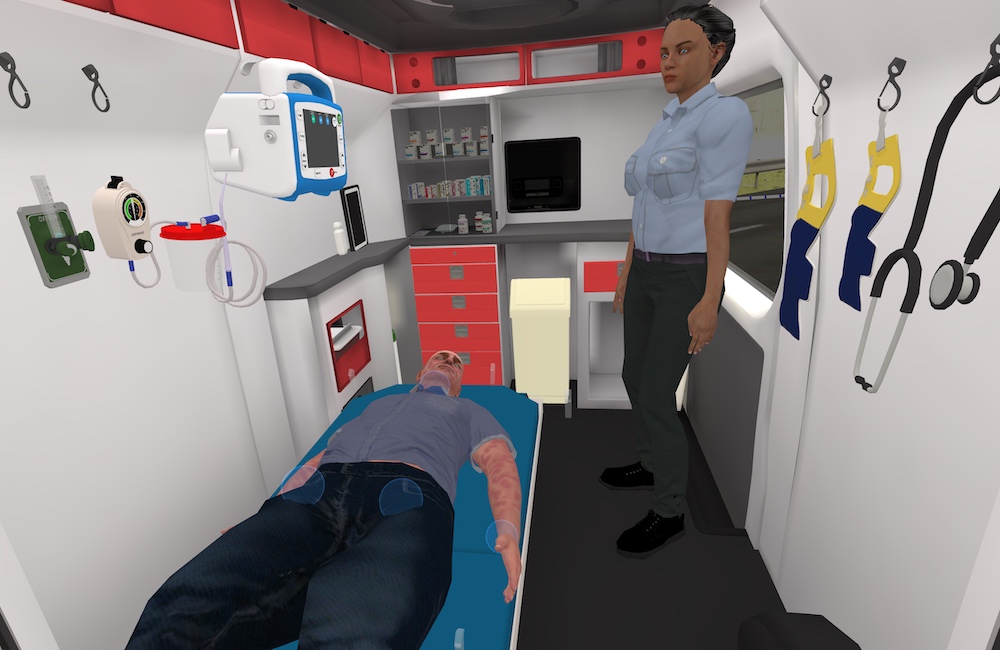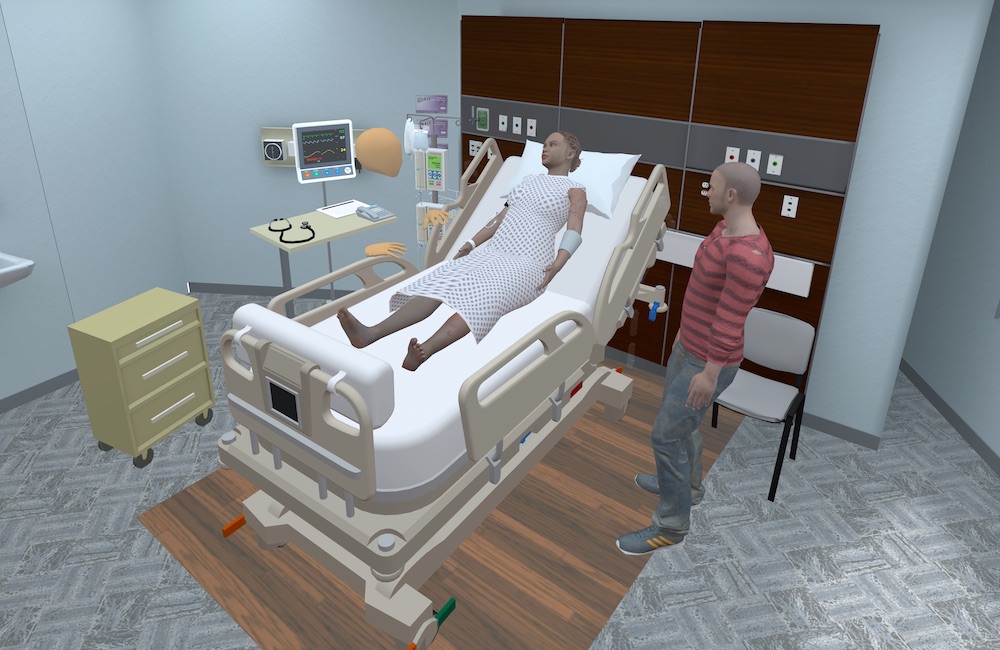Improving Patient Safety With the SimX Virtual Reality System
Simulation has been used for decades to train and prepare professionals for real-life experiences by mimicking true-to-life scenarios. With roots in the aviation industry, the practice has become a widely recognized method to ensure that learners have the skills necessary to perform their expected duties and responsibilities. Now prevalent across medical education, clinical simulation has provided a way for healthcare systems to strengthen patient safety and ensure optimal care. Specifically, this HealthySimulation.com article highlights how these systems and others can improve patient safety with the SimX Virtual Reality (VR) System.
To provide background, commercial airline flights used to be seen as risky endeavors that ended in disaster all too often. However, within the last 40 years, a significant change in required simulation training for all pilots made flying drastically safer. Where pilots were once expected to learn many skills on the job, they now operate and practice on simulated planes long before they take off with a cabin full of passengers. Flying across the country is now considered safer than the short drive to the airport. Much of the credit for this advancement can be attributed to the rise of simulation training for pilots worldwide.
Learning on the job proved to be not only dangerous but ineffective in teaching skills needed to fly safely and efficiently. The same “learn on the job” attitude has been seen far too often across the healthcare industry. Multiple studies in the United States have pointed to preventable hospital errors as a leading cause of death, and thus, improvements must be made to clinical training and educational experiences.
Sponsored Content:
While healthcare simulation training has gained popularity, many skills are still taught through direct experience with real-life patients – leading to morbidity and mortality. Yet, this is because the practice of clinical simulation often relies on cumbersome, time-consuming, and expensive manikins or task trainers. This brings learners and educators to “The Manikin Problem.”
The Manikin Problem
In a similar manner to the airline industry, healthcare educators have attempted to recreate real-life situations for replicative practice. This has primarily been accomplished with the invention of mechanized human facsimiles, which are often referred to as “high-fidelity simulation manikins.” Advances in silicone and other synthetic materials have improved the appearance of these human imitations; however, the ability to act as an actual patient is still severely lacking.
For example, a manikin can’t emulate neurological deficits or exhibit psychosocial stress. Traumatic effects or dermatological findings are challenging to emulate due to the amount of time, effort, and resources that go into creating these effects on a manikin. Relying on a manikin to sit up and vomit blood or walk across a room and collapse is also currently impossible.
Sponsored Content:
To add complexity, traditional healthcare simulation requires numerous medical tools and devices to practice any given scenario. The high cost of acquiring and operating the right ventilators, chest tubes, medications, test vials, drapes, cardiac monitors, etc., only adds barriers to successful immersive clinical simulation.
Virtual Reality Simulation
With VR, the issue of not being able to acquire real appearing interactive patients has been solved. VR simulations allow learners to utilize medical devices and assess, diagnose, and treat patients just as they would in a natural clinical setting. Training no longer needs to be a singular static experience, but can be customized to fit the needs of both learners and educators.
To this end, many VR software solutions support automatic action recognition that adjusts the patient’s state accordingly. Tools and medical devices can also be created and included in VR without the need for their expensive, bulky real-world counterparts.
The SimX Solution
The SimX Virtual Reality Medical Simulation System (VRMSS) is a platform that allows learners to practice their diagnostic and treatment skills on any patient, in any environment, and with any tools. This system allows educators and learners to interact with and accomplish dynamic patient encounters in a variety of environments focused not just on essential patient care but on addressing the psychosocial needs of each patient through real-time communication with the patient and family members.
While each healthcare simulation scenario follows a state-flow pattern, educators act as moderators to control and direct how the case unfolds. During the scenarios, learners are expected to complete a full spectrum of essential tasks, from obtaining a thorough history and exam to diagnosis and final treatment. Other functionality for the SimX VRMSS includes assessments, non-collocated team training, and custom patient encounters, including:
Real-Time Assessment and Tracking: The SimX VRMSS provides users with powerful reporting and debrief tools that allow them to track objective performance over time and facilitate effective debriefs and feedback sessions. SimX reports track and time stamp critical actions so educators can review performance and progress with their learners in a standardized way. Users can also record the full clinical simulation session for later review.
Remote & Non-Collocated Training: Using SimX’s multiplayer capability, many learners can join the same virtual space at any time for lectures, special demonstrations, or group training. Whether remotely or in the same physical space, SimX users can learn and practice together to gain not only technical skills but also communication and social skills. The VRMSS also allows for non-collocated team training, meaning team members are not required to be in the same physical space to share the same virtual space.
Custom Simulated Patient Encounters: Each SimX simulated patient encounter is designed by a cross-functional development team in close collaboration with SimX clients. During pre-production, a collaborative team generates a high-level concept that broadly defines the desired scenario and learning goals.
From this concept, a SimX medical SME works with customers to develop further specifications that outline state flow, characters, tools, and environments. These specifications become the foundation from which the SimX development team begins to develop the scenario that addresses the needs of both learners and educators.
Virtual patient encounters are more accessible than traditional medical simulation training and allow learners to repeat essential scenarios, work in collaborative teams, and customize patient encounters to specific learning objectives. With VR-MST like SimX, learners can practice diagnostic and treatment skills again and again with a level of realism to better translate learned skills into real-life know-how.
Envisioning a Safer Future
Every generation of healthcare professionals looks back on those that came before and marvel at how far the field has changed and developed for the better. Many modern tools and procedures are now standard and impossible to imagine being without. For example, learners may struggle to believe that properly sanitizing tools or washing hands before treating patients used to be uncommon.
SimX operates under the belief that Virtual Reality Simulation Training is a tool that will one day be so integral to all medical training processes that practitioners and learners everywhere will not be able to imagine a time when this educational method wasn’t an essential part of their training. Just as modern pilots never attempt to fly a plane without extensive flight simulation training, there will come a future where medical professionals are no longer left to “learn on the job” or in the absence of truly realistic simulation training.
Advances in VR technology will lower the barrier to high-fidelity training and make clinical simulation more accessible. If professionals and learners are given a chance to understand and practice in a virtual environment rather than on limited, one-dimensional manikins or on patients themselves, safety in patient care will increase and result in far fewer medical errors.
The SimX VRMSS was created with the simple vision of saving lives. Created by clinicians for clinicians, SimX is passionate about providing accessible training and educational experiences to optimize real-life procedures and treatments. With SimX, learners everywhere can better train to treat patients safely and with greater attention, emotional intelligence, and accuracy.
More About SimX
SimX, previously called SimXAR, is a healthcare software company specializing in medical simulation, virtual reality, augmented reality, and medical training and education. The company brings virtual and augmented reality into the realm of healthcare simulation and training. SimX was founded by physicians in training at Stanford, the University of California at San Francisco, and the University of California at Los Angeles.
They understood that simulation practice and training are extremely beneficial to both learners and clinicians and hoped to use virtual reality to make simulation cheaper and more accessible, to ultimately reduce medical error and increase patient safety. Seeking to push simulation forward, SimX developed a software system that was the first comprehensive professional-grade VR medical simulation system product available on the market.
Founded in 2013 and headquartered in Mountain View, California, the platform allows medical teams to replace expensive manikins with incredibly flexible simulated patients, backed by a robust case creation engine.
Learn More About SimX
Sponsored Content:


















